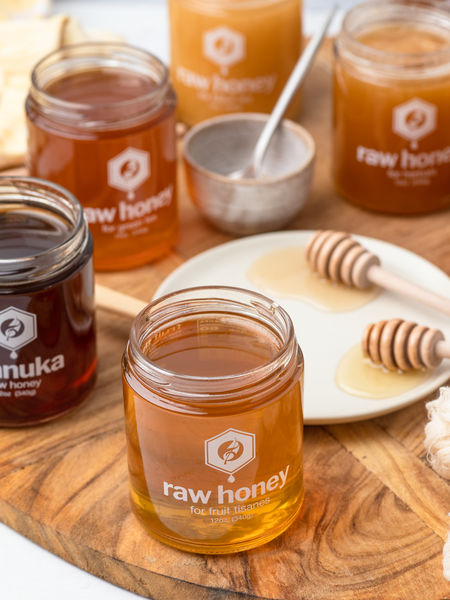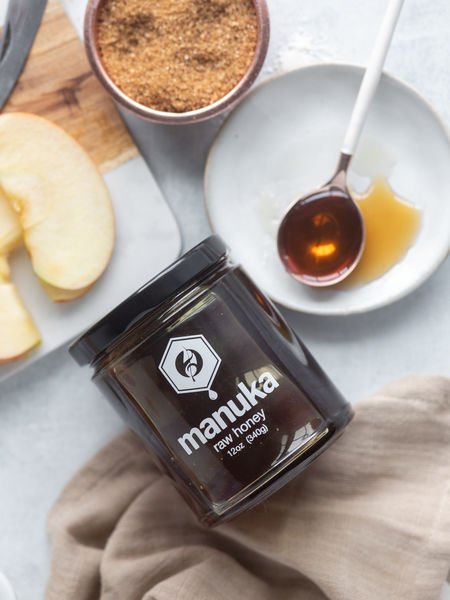Beginner's Guide to Honey


Archaeologists have discovered clay jars of honey, and pottery with beeswax still clinging to the surface, in tombs and ancient ruins from at least the end of the stone age of 10,000-8,000 BCE. Paintings in caves in Valencia, Spain that date between 9000 and 4000 BCE depict men climbing ladders to retrieve beehives and beekeeping remnants in ancient Egypt date to 2600 BCE. What is it about this nectar that has lasted over millennia? We believe it’s not only the sweet taste, but also its texture and its ability to bring out the flavors of other ingredients in recipes we bake, cook, or use for beverages.
Adagio Tea currently offers eight raw honeys specifically chosen to enhance our teas: Manuka, Tupelo, Sourwood, and honey they suggest to pair with green tea, black tea, fruit tisanes, garden herbals, and rooibos. Try one or two or all! Excellent to bake or cook with, too.
HONEY VARIETALS
More than 300 varietals have been discovered in the U.S alone, and there are thousands more throughout the world. Among the U.S. varietals are honeys made from blueberry, clover, black locust, goldenrod, knotweed, orange blossom, sourwood, and tupelo. Each tastes sweet, yet the blossom or fruit of the plant or tree lends a signature scent to each.
The texture of honey ranges from delicately light and creamy to heavy and intense, especially in their raw, unfiltered forms. Like wine (or tea!) it is terra firma, temperature, and rainfall that impact the taste of honeys from year to year even when they’re made from flowers grown in the same location.
RAW HONEY
The National Honey Board defines raw honey as “honey as it exists in the beehive or as obtained by extraction, settling or straining without adding heat.” Raw honeys are never heated above 110˚ F. and the natural health-giving pollen is not filtered out. Processing may also include additives and chemicals.
Honeybees are seven members of the genus Apis, but it is the domestic honeybee (Apis millefera) that creates the honeys we enjoy. Honeybees use nectar from flowers and plants, not pollen, to make honey. Pollen is an “accidental guest” carried by the bee to the hive where, when available, it is fed to the baby bees. The amount of pollen in raw honey is miniscule and doesn’t impact the nutrient value.
HEALTH BENEFITS
The 12th century sage and physician, Maimonides, believed that honey mixed with warm water could ease digestive woes of the elderly, but warned that it was bad “for children and good for the elderly, certainly in the rainy season.” Today’s scientists partly agree; they advise that no infant under one-year-old should consume honey.
There’s a good reason why honey in tea is the time-honored therapy for those with colds or minor sore throats; it soothes minor irritation, works in both herbals or true teas, and its impact is to help loosen congestion, and unlike a lot of cough syrups and meds, honeyed tea tastes delicious. It is great for minor sore throats.
Honey also may act as an antibacterial when applied to minor abrasions and is a natural energy booster with no side effects. Consumed before exercising helps maintain muscle glycogen (stored carbs) to give you an energy boost.
Nutritionally, honey has a wide array of vitamins, minerals, amino acids, enzymes, and antioxidants including flavonoids and phenolic acids although the amount, and type, are directly related to the flower sources. It is a complex sugar, with sucrose, fructose, glucose, maltose, and trisacharides; about 17 grams of carbohydrates per tablespoon; 30 calories per teaspoon, so you can eat it daily albeit in moderation.
STORAGE AND CRYSTALLIZATION
Optimally, a jar of honey has a typical shelf life of two years when stored away from intense cold or heat or direct sunlight. It may last longer.
Even while stored properly in sealed container, honey can crystalize which is when the glucose separates from the liquid in honey. Crystallization may darken the honey’s color or reduce the honey’s flavor or aroma, but it is still useable. It is totally safe (and delicious) to eat crystalized honey.
Do not refrigerate. If a houseguest or gremlin puts a jar in the fridge, remove it and allow it to come back to room temperature to dissolve any crystallization. Stir and use.
Another way to de-crystalize your honey is to place the jar under a spout of hot water. Or, place it into a bowl of hot water for 10-15 minutes or until the crystallization dissolves thoroughly.
SUBSTITUTING HONEY FOR SUGAR IN BAKING OR COOKING
Honey is heavier than water which is why it is sold by weight rather than by volume. One cup of honey weighs 12 ounces while one cup of water holds 8 ounces.
Honey is sweeter than sugar and provides added moisture to baked goods so adjustments should be made when substituting honey for sugar. The National Honey Board suggests these guidelines:
• Substitute honey up to half of the sugar called for in a recipe. For example, if ingredients list 1 cup of sugar, use ½ cup of honey.
• When making baked goods, reduce the liquid in the recipe ¼ cup and add ½ teaspoon of baking soda for each cup of honey used
• Reduce oven temperature by 25º to prevent over-browning of baked goods.
• Adding honey to savory dishes brings out seasonings in sauces and marinades and balances soft/sharp flavor profiles.
• Honey adds sweetness to both alcoholic and non-alcoholic beverages, hot or cold
